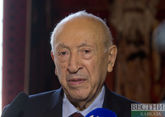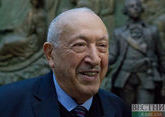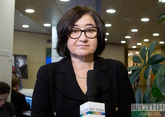On November 29th, Azerbaijani and Russian painter, theater artist, teacher, Vice President of the Russian Academy of Arts, People's Artist of the USSR, Hero of Socialist Labor, laureate of the USSR State Prize and the State Prize of the Russian Federation Tahir Salakhov celebrated his 90th anniversary. Vestnik Kavkaza spoke with the daughter of the painter Aidan Salakhova, who is an artist, sculptor, gallery owner, and a public figure, teacher, professor, academician of the Russian Academy of Arts.
- President of Russia Vladimir Putin, President of Azerbaijan Ilham Aliyev, First Vice President of Azerbaijan, President of the Heydar Aliyev Foundation, Goodwill Ambassador of UNESCO and ISESCO Mehriban Aliyeva sent congratulations to Tahir Salahov. He was honored at the Russian Academy of Arts. And how did you celebrate the holiday in the family circle?
- We celebrated at the Academy, and afterward father, his wife, Azerbaijani ambassador to Russia, Polad Bulbul oglu, with his wife and I went to dinner at my father's favorite Chinese restaurant. Dad did not want to celebrate with a lot of people.
I remember that on one of his birthdays, I worked in Italy, and he said: "Do not come, the main thing is work."
- We know your father as a classic, master of a painting of the world scale. And what kind of person is he? What are his interests and hobbies besides painting?
- He is all about creativity. But he loves traveling and cooks amazingly.
- What is his speciality?
- A mutton piti soup and baked lamb jiz byz. He is the best cook I know.

- What artists of the past or contemporary artists became patterns of inspiration for him?
- I can not name specific artists, not to offend others. He has many preferences.
- Does he still work?
- Of course. Every morning, starting from 11-12 am and up to 3 pm, he works. This time is inviolable.
- How does he work? Is this a slow and thoughtful process? Are the works born quickly?
- This is a slow and thoughtful process. First, a detailed sketch is made, usually watercolors from nature, then sketches, then watercolor of the exact sketch, then the composition is set, and then everything is transferred to the canvas. That is the main creative process - the creation of a composition in sketches. His sketch is always absolutely accurate and corresponds to the painting. If you look at his development of portraits of Rostropovich, Shostakovich, you will see that there was a long preparatory work, and then only there was a transition to a large format. But when he goes to the canvas, everything is already decided with the mathematical precision.
- What kind of relationship has developed between you - as between father and daughter, or as between two creators? Can you call yourself his student?
- We have three kinds of relationships. He treats me like a daughter, as a very little girl, I may say; as a student and as a colleague. These three phases of communication alternate.
- Do you argue like the colleagues?
- I listen to him because he is always right.
- Which of his paintings is your favorite?
- ”For you, humanity!"

- Has his attitude to this picture changed, or since the moment of its creation, he perceives it the same way?
- I can say about my feelings. The first time I saw this picture, when I was about six or seven years old, in the Azerbaijan National Museum in Baku. At that time I usually saw his works in his workshop. I remember well the picture "Women of Absheron."

And ”For you, humanity!" I saw in the museum. It was of a huge format. Then I acquired it not as my father’s work, but as a museum’s masterpiece that had a great effect on me. This picture was not similar to the ones I saw in the workshop.
The second time I saw it in Baku in the early 2000s. Then I went to the museum and asked where “For you, humanity!” was located. I was told that it was on the attic of the museum behind bars, since such a large canvas of this format does not fit anywhere. I went there and saw that it was not restored, there were holes in the painting. Then I promised myself that I would do everything to help the museum to restore this work. Ten years ago, when we were preparing daddy's exhibition for his 80th anniversary in The Ekaterina Cultural Foundation, we received sponsorship money, which the Safarovs family kindly provided us. With this money, we restored all the works of Tahir Salahov, which were in the collection of the Azerbaijan Museum.
By the 80th anniversary, I also did a solo exhibition of my father in my gallery at Winzavod. I believe that this was the best exhibition in my gallery because nothing was represented on it except this amazing work. Seeing such a picture at the Winzavod among youth exhibitions, people were afraid to come close to it, and looked from a certain distance, like on Mona Lisa. This piece is very strong.
- Can it be called the main work of your father?
- I think yes.
- Let's talk about the picture ‘Aidan’. Do you recognize yourself on it?
- Yes. I was born into a family of artists, and my sister and I were forced to pose for mom and dad. I can not say that it was our favorite pastime because getting a small child to sit still for two or three hours is very difficult. There was an internal protest. And now, when I am forced to pose even just in front of the camera, I have internal resistance. This is a complex of the artists’ children. I remember that it was very hot to sit in this coat. I was swinging on the horse all the time. I do not know how he painted, because I did not obey, all the time I was in motion. But he caught the moment.

- How is it to be a prototype of one of the most replicable images?
- I remember that in my childhood I was annoyed when people said about me:“ Oh, this is the girl on the horse.’’ But now it’s nice to come to the Tretyakov Gallery and take a selfie against the background of this portrait.
- Your father is one of the main artists of the USSR. Did he define himself somehow in the national paradigm? Does he feel like an Azerbaijani artist or a Russian?
- We were all born in the USSR, we all felt (I still feel) as people born in a single space where there were no borders. Therefore, Dad has such a feeling - out of the boundaries.
- And do you identify yourself that way?
- Yes.
- Is an agave, which often appeared in the pictures of your father, planted by your grandmother, still growing in your country house?

- Yes. Dad loves agaves, we have a lot of them.
- Is he a religious person?
- Artists are the people who believe in art. This is the main religion of artists. At the same time, through creativity, there is respect for all religions that exist. If you got into the history of art, your work remained in eternity, it means that you went to heaven. If you do not get into the history of art, then you are in hell. I am an atheist.
- Tair Teymurovich once said about his work: "This is a long and painful process, after which you feel a sense of happiness." Do you agree with this statement?
- Of course. Creativity, any creation of a work is an agonizing process, where every line is painstakingly crafted, thought out. During the creation of works, doubts and sufferings overwhelm an artist. This is not visible to the audience, but an artist understands.
- Your father’s art is of a so-called ”severe style”. Has his style influenced you in any way?
- Of course. His school influenced me. We, his students, became the followers of his work, his style. This is a clear line, the color of the sky, the color of the earth on the Absheron landscapes. In Azerbaijan, there is a special kind of sunlight, such an illumination, which is shown on daddy’s landscapes. In Italy, for example, there is another lighting, and in Azerbaijan - absolutely clear lines and contrasts, the extraordinary clarity of these strict lines, the edges of houses, architecture.

- The childhood of Tahir Teymurovich was overshadowed by the story of his father, repressed for a false accusation. How did he manage to live with it?
- Yes, it is a serious injury. A very complex topic. He always believed in his father, believed that he was not guilty of anything. I think this faith saved him.
- An artist should be in opposition to the government, not only the state but to the power of trends, ideas? Or is an artist a person who forms them?
- The artist must be independent and internally free. If you are opposed to something, you are not free, you are contained. The inner freedom allows us to be objective, adequate and correctly perceive reality. Dad, like any interesting artist, has his own world, his own independence. His work is perceived by young people and those in power because it does not depend on anything. He has inner freedom. Plus, the incredible trait he gave me is love for other artists, for other people's creativity, respect for any work, whether it is pleasant or not. He always respects the work of the artists, he is interested in them. The circle of artists is so envious, competitive. A competition also puts you in a framework of dependence. But dad never competed with anyone internally, so there is love for other artists and freedom in him.

- Tahir Salahov has always been considered a bridge between East and West, Russia and Azerbaijan. Do you consider yourself his successor?
- Yes. Dad puts himself above all borders and thinks globally without noticing boundaries. The territory of art is a single field. Now there are exhibitions of Russian art, Azerbaijani, German - this is absolute nonsense, because art cannot be divided into nationalities or countries.
- What is the secret Tahir Salakhov’s longevity?
- He eats properly. For breakfast, cottage cheese or yogurt. His lunch is heavy because Azerbaijani food is very rich with calories. He drinks kefir for dinner.
In fact, many artists live long. They have no time to get sick because they need to paint pictures, they always have a lot of plans. I think dad will create a lot of works in the future.










